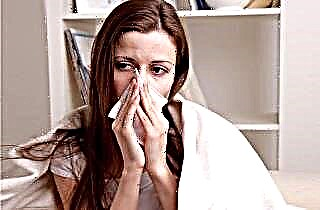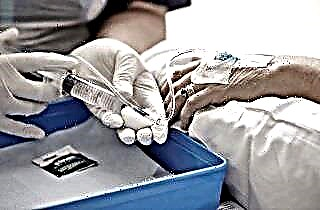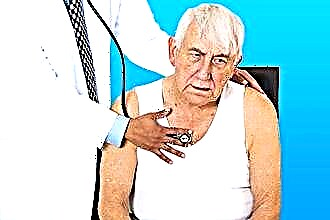Cancer of the nose is rarely diagnosed. Its total number is less than 1% of all cancer patients, and this is taking into account the fact that malignant tumors of the nose have many varieties. For reasons that still remain unclear, the disease is more common in older and older men. But some forms of cancer even affect children.
Possible reasons
 To this day, science has not yet been able to unambiguously establish the cause of the appearance and development of any neoplasms. More or less accurately, medicine names only provocative factors that increase the likelihood of the appearance of malignant tumors:
To this day, science has not yet been able to unambiguously establish the cause of the appearance and development of any neoplasms. More or less accurately, medicine names only provocative factors that increase the likelihood of the appearance of malignant tumors:
- Constant or excessive exposure to physical and chemical irritants. Allergy sufferers and people working in "harmful" industries are at risk. Cancer of the respiratory system (not only of the nose!) Is much more common among residents of megacities, who practically do not go to nature.
- Smoking and inhalation of toxic drugs (glue, cocaine, other drugs) through the nose leads to constant irritation and damage to the nasal mucosa, the formation of chronic ulcers, polyps on it, and changes in epithelial cells. As a result, cancer of the nasal mucosa may develop.
- Chronic inflammation in the nasal cavity or sinuses. Chronic sinusitis, rhinitis, constantly inflamed adenoids, polyps in the nose can provoke the appearance and growth of malignant neoplasms.
- Some types of neoplasms. Adenomas, warts, papillomas, some types of moles under the influence of other negative factors can degenerate into malignant tumors. This is why it is so dangerous to pick, cut or dispose of them in any other way on your own.
Among the causes of the onset and development of cancerous tumors, modern doctors also call a greatly reduced immunity, which may be the result of vitamin deficiency, an unhealthy lifestyle and frequent exacerbations of chronic diseases of internal organs.
A strong immune system is able to completely suppress the growth of cancer cells, while a weak one cannot even significantly inhibit it.
The main symptoms
At an early stage, nasal cancer usually does not give clear symptoms, so it can be very difficult to recognize it. At first, the symptoms are generally similar to chronic rhinitis or sinusitis: a constant runny nose, a feeling of nasal congestion, perhaps a feeling of pressure in one of the sinuses. And only as the tumor grows (which can be quite fast!), Concomitant symptoms typical for oncological diseases begin to appear:
 physical weakness, fatigue;
physical weakness, fatigue;- general intoxication of the body: nausea, dizziness;
- in mucous secretions - traces or blood clots;
- severe nasal congestion on one side;
- periodic nosebleeds;
- neurological pain in the face;
- a sharp drop in immunity.
If the cancer of the nose is localized on the surface of the skin, then over time, the neoplasm becomes visually noticeable. Cancer of the nasal cavity, germinating, can affect the middle ear, nasopharynx and even the mucous membrane of the eye. The only way to accurately diagnose cancer is with a biopsy.
Diagnostic methods
The symptoms listed above help to suspect nasal cancer, on the basis of which the primary diagnosis is made: a visual examination, palpation of the lymph nodes, an anamnesis is made. If the lymph nodes behind the ear or cervical are enlarged, then there is a high probability that the cancer has already metastasized.
Then a rhinoscopy is performed using a device that widens the nasal canal and allows you to see the nasal cavity in more detail. If cancer is suspected in any of the sinuses, then the examination is carried out using an endoscope - a thin tube, at the end of which a miniature video camera is usually fixed.
Modern equipment allows not only to penetrate deep into the nasal cavity in a low-traumatic way and display the image on the monitor, but also to take tissue samples for cytological examination. This procedure is called a biopsy and is a necessary diagnostic step.
 As additional procedures are used:
As additional procedures are used:
- general blood test - allows you to determine the level of hemoglobin and leukocytes, the presence of inflammatory processes and the general condition of the patient;
- biochemical blood test - gives a more detailed picture of the key indicators of blood composition;
- a blood test for tumor markers - the presence of cancer cells in the body causes a certain protective reaction of the immune system, which begins to actively produce antibodies;
- X-ray of the nose and sinuses - allows you to visually see the neoplasms, assess their size, roughly determine the location;
- computed tomography - determines the density and exact location and size of the neoplasm, reveals the presence of metastases.
If, according to the test results, nasal cancer is established, but the patient is registered in an oncological dispensary and further treatment is prescribed and monitored by an oncologist.
Cancer varieties
There are many types of nasal cancer and only cytological analysis can determine exactly which one is affected by the patient. It shows what types of cells the tumor consists of and can partially indicate the reasons for its appearance. In 4 out of 5 cases, squamous cell carcinoma of the nose is diagnosed, when flat epithelial cells degenerate and grow uncontrollably. When localized on the surface or on the nasal mucosa, it responds well to treatment with radiation and, in the absence of metastases, can be completely healed quickly enough.
 Cancers are divided into two large groups: tumors of the pyramid of the nose, localized directly on the nose or in the nasal passages, and tumors of the nasal cavity - much more difficult to access neoplasms that grow inside in the nasal cavities and sinuses. It is definitely more difficult to recognize and detect the second type of tumor in time.
Cancers are divided into two large groups: tumors of the pyramid of the nose, localized directly on the nose or in the nasal passages, and tumors of the nasal cavity - much more difficult to access neoplasms that grow inside in the nasal cavities and sinuses. It is definitely more difficult to recognize and detect the second type of tumor in time.
The most aggressive and dangerous type of cancer is sarcoma, which also takes various forms:
- fibrosarcoma - formed from altered fibroblasts and affects the soft tissues of the nose;
- chondrosarcoma - affects the cartilage tissue, which is a building material for it;
- osteosarcoma - very diverse, consisting of several types of cells, metastases already at an early stage of cancer;
- lymphosarcoma - formed from reborn lymphocytes, appears in the middle part of the nose or on the septum, quickly affects the lymph nodes and spreads further.
These neoplasms, in the absence of adequate treatment, grow very quickly and give numerous metastases, spreading throughout the body through the blood, and lymphosarcoma through the lymph.
General treatment regimen
Unfortunately, there is still no effective treatment for cancer at this time. The problem can be radically solved by a surgical operation to excise the tumor and nearby tissues. But this is not always possible, since often the very location of the neoplasm excludes surgical intervention. In addition, if the tumor has already metastasized, then its elimination will not lead to complete recovery.
For each patient, based on his general condition, type and characteristics of the tumor, a complex treatment scheme is developed, which consists of several types of exposure:
 Radiation exposure is the effect of directed radioactive radiation on a tumor, which is detrimental to cancer cells. To prevent the development of a tumor, neighboring lymph nodes and nearby tissues are also irradiated. After a course of radiation therapy, surgery is performed if necessary.
Radiation exposure is the effect of directed radioactive radiation on a tumor, which is detrimental to cancer cells. To prevent the development of a tumor, neighboring lymph nodes and nearby tissues are also irradiated. After a course of radiation therapy, surgery is performed if necessary.- Chemotherapy is the introduction into the body of chemical compounds destructive for cancer. Unfortunately, they are toxic to the whole body, therefore chemotherapy is rather difficult for patients to tolerate. But this type of treatment is necessary if tumor metastases have spread to neighboring organs.
- Drug therapy - usually carried out after courses of chemistry or radiation exposure and is aimed at eliminating their negative consequences, as well as increasing the patient's immunity. The drugs are selected individually.
In the absence of metastases, the likelihood of a complete cure for nasal cancer is very high, especially if it is detected at an early stage. However, the disease requires the patient to strictly follow all medical prescriptions, completely abandon bad habits and adhere to a sparing diet and a healthy daily regimen.
Once the cancer is advanced, it is impossible to predict the outcome of the disease. However, repeated courses of treatment can significantly inhibit tumor growth and prolong the patient's life for several years.
But it is still better not to get an appointment with an oncologist, and for this you should regularly take preventive measures.
Prevention measures
Since the true causes of the appearance of malignant neoplasms have not been established, it is impossible to say unequivocally which actions can completely prevent cancer. However, observing simple preventive measures, you can reduce or completely eliminate the influence of negative factors that contribute to the development of cancer:
 Strengthening the immune system. The best cancer prevention tool. It is immune cells that are the first to attack malignant neoplasms and prevent their growth. Therefore, it is necessary to strengthen the immune system by all available means: regular use of hardening procedures, physical activity, periodic intake of immunomodulators.
Strengthening the immune system. The best cancer prevention tool. It is immune cells that are the first to attack malignant neoplasms and prevent their growth. Therefore, it is necessary to strengthen the immune system by all available means: regular use of hardening procedures, physical activity, periodic intake of immunomodulators.- Neutralization of free radicals. Modern research has shown that the transformation of ordinary cells into cancerous cells is facilitated by the presence in the body of free ions of certain substances, the so-called "free radicals". Antioxidants help neutralize the harmful effects, the most powerful of which are vitamins C and E, which are present in large quantities with fresh fruits, vegetables, and herbs. These foods should be on your table every day.
- Ultraviolet limitation. Ultraviolet radiation contributes to the formation of free radicals, especially if it affects the body for a long time. Lovers of sunbathing on the beach or regulars of tanning salons are much more likely to become patients of oncologists. The maximum permissible time for a person to be exposed to direct sunlight is up to 20 minutes a day. But do not confuse diffused sunlight and directional beams in a tanning bed. You can stay there without harm to health for no more than 5 minutes, and then provided that the skin is protected by a cream with a sunscreen filter of at least 15.
- Timely treatment of any inflammatory processes in the respiratory system. In the human body, everything is interconnected and even chronic bronchitis can provoke cancer of the nasal cavities, as it weakens the immune system and provokes permanent inflammation of the mucous membrane. If nasal and sinus inflammation is caused by the presence of polyps, it is best to remove them surgically.
 Quitting bad habits generally helps to improve health and overall well-being. Bad habits lead to chronic general intoxication of the body and a strong decrease in immune defense, and some of them, for example, smoking, provoke inflammation of the mucous membrane and degeneration of its cells.
Quitting bad habits generally helps to improve health and overall well-being. Bad habits lead to chronic general intoxication of the body and a strong decrease in immune defense, and some of them, for example, smoking, provoke inflammation of the mucous membrane and degeneration of its cells.- Use of protective equipment. When working in "harmful" industries, it is mandatory to use devices for respiratory protection: masks, respirators, gauze bandages, etc. Do not neglect them. Residents of megalopolises can be recommended air ionizers, which purify, humidify it and contribute to the settling of dust and microparticles of dirt flying in the air.
Of course, these measures will not give a 100% guarantee that you will never get nose cancer, but they significantly reduce its likelihood.
But even if such a diagnosis has already been made, it is important not to panic and not give up, but immediately contact a specialist and begin a course of treatment. Remember that the likelihood of a favorable outcome is very high and you should do everything possible to increase this percentage.

 physical weakness, fatigue;
physical weakness, fatigue; Radiation exposure is the effect of directed radioactive radiation on a tumor, which is detrimental to cancer cells. To prevent the development of a tumor, neighboring lymph nodes and nearby tissues are also irradiated. After a course of radiation therapy, surgery is performed if necessary.
Radiation exposure is the effect of directed radioactive radiation on a tumor, which is detrimental to cancer cells. To prevent the development of a tumor, neighboring lymph nodes and nearby tissues are also irradiated. After a course of radiation therapy, surgery is performed if necessary. Strengthening the immune system. The best cancer prevention tool. It is immune cells that are the first to attack malignant neoplasms and prevent their growth. Therefore, it is necessary to strengthen the immune system by all available means: regular use of hardening procedures, physical activity, periodic intake of immunomodulators.
Strengthening the immune system. The best cancer prevention tool. It is immune cells that are the first to attack malignant neoplasms and prevent their growth. Therefore, it is necessary to strengthen the immune system by all available means: regular use of hardening procedures, physical activity, periodic intake of immunomodulators. Quitting bad habits generally helps to improve health and overall well-being. Bad habits lead to chronic general intoxication of the body and a strong decrease in immune defense, and some of them, for example, smoking, provoke inflammation of the mucous membrane and degeneration of its cells.
Quitting bad habits generally helps to improve health and overall well-being. Bad habits lead to chronic general intoxication of the body and a strong decrease in immune defense, and some of them, for example, smoking, provoke inflammation of the mucous membrane and degeneration of its cells.

